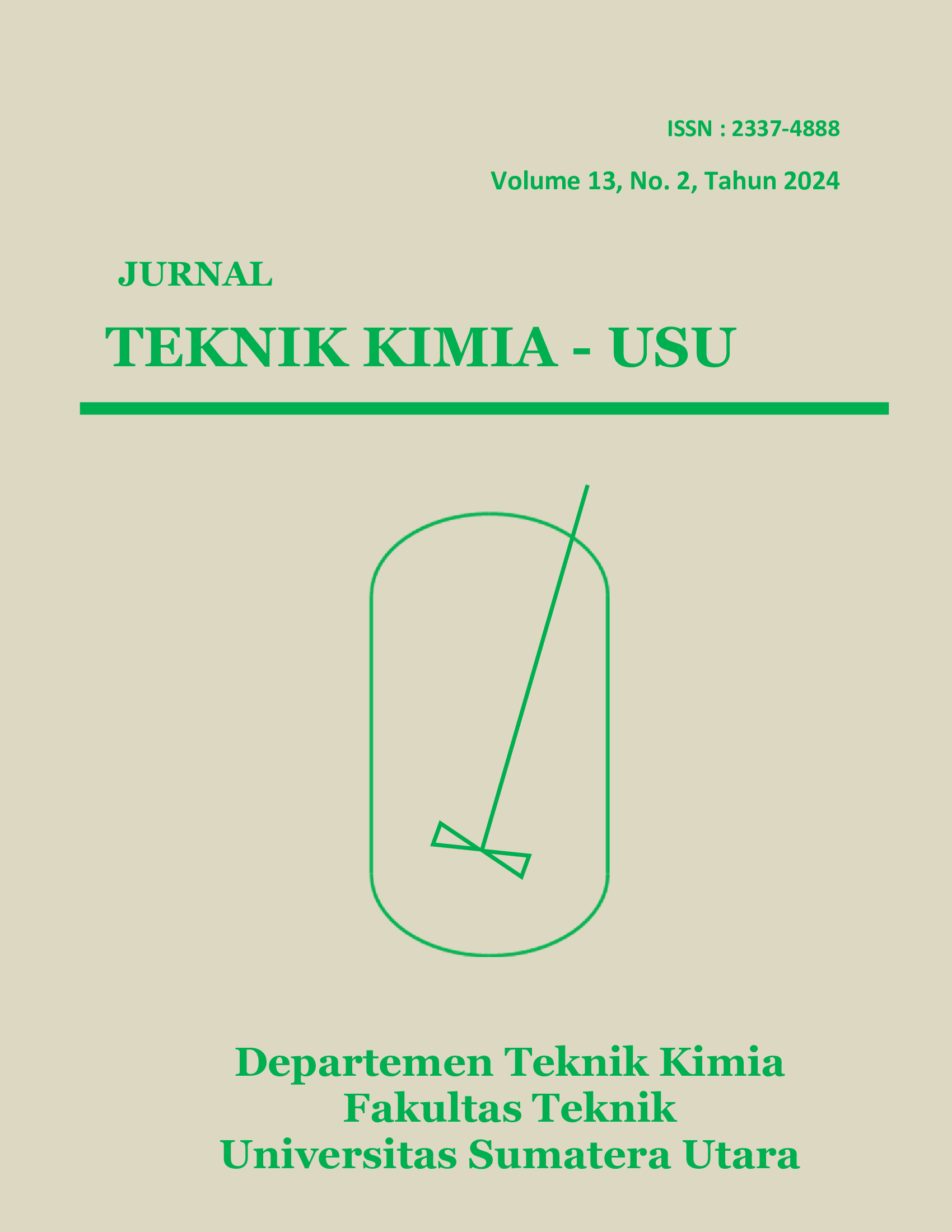Pengaruh Waktu Iradiasi Ultrasonik dengan Aktivasi Kalium Hidroksida terhadap Sifat Fisis Karbon Aktif dari Serbuk Karet End Life Tire
DOI:
https://doi.org/10.32734/jtk.v13i2.15549Keywords:
KOH activation, ultrasonic, activated carbon, physical properties, ELT rubber powderAbstract
Processing End Life Tire (ELT) rubber powder into activated carbon is an alternative for handling tire waste. One way to improve physical properties such as proximate characteristics, surface area and pore diameter of activated carbon is through chemical activation assisted by ultrasonic irradiation. This research aims to determine the effect of ultrasonic irradiation time with potassium hydroxide (KOH) activation on the quality of ELT rubber activated carbon. Activated carbon was synthesized and activated using 30% KOH at various ultrasonic irradiation times, namely 0 minutes, 15 minutes, 30 minutes, 45 minutes and 60 minutes. Based on the characterization results, activated carbon with an ultrasonic irradiation time of 30 minutes is the active carbon that has the most superior properties. The proximate characteristics of activated carbon meet the active carbon quality requirements of SNI 06–3730–1995 and have the highest surface area, namely 401.11 m2/g and pore diameter of 2.1652 nm, which is included in the mesoporous structure category so that it has the potential to be applied as an adsorbent for heavy metals from contaminated fluid.
Downloads
References
F. Valentini and A. Pegoretti, “End-of-life options of tyres. a review,†Advanced Industrial and Engineering Polymer Research, vol. 5, no. 4, pp. 203–213, 2022.
S. Dabic-Miletic, V. Simic, and S. Karagoz, “End-of-life tire management: a critical review,†Environmental Science and Pollution Research, vol. 28, pp. 68053–68070, 2021.
N. Muttil, S. Jagadeesan, A. Chanda, M. Duke, and S. K. Singh, “Production, types, and applications of activated carbon derived from waste tyres: an overview,†Appl. Sci, vol. 13, no. 257, 2023.
X. Junqing, Y. Jiaxue, X. Jianglin, S. Chenliang, H. Wenzhi, H. Juwen, and L. Guangming, “High-value utilization of waste tires: A review with focus on modified carbon black from pyrolysis,†Science of the Total Environment, vol. 742, 2020.
H. M. Tabbakh and R. M. Barhoum, “Preparing of activated carbon from tyre wastes and using it in adsorbing spilled oil on water bodies,†World Appl Sci J, vol. 37, no. 6, pp. 458–464, 2019.
A. Ariri, S. Alva, and S. A. Hasbullah, “Tire waste as a potential material for carbon electrode fabrication: a review,†SINERGI, vol. 25, no. 1, pp. 1–10, 2020.
T. M. Setyoningrum, A. Setiawan, and G. Pamungkas, “Pembuatan karbon aktif dari hasil pirolisis ban bekas,†Eksergi, vol. 15, no. 2, pp. 54–58, 2018.
K. Manirajah, S. V. Sukumaran, N. Abdullah, H. A. Razak, and N. Ainirazali, “Evaluation of low cost-activated carbon produced from waste tyres pyrolysis for removal of 2-chlorophenol,†Bulletin of Chemical Reaction Engineering & Catalysis, vol. 14, no. 2, pp. 443–449, 2019.
Sirajuddin and D. Bith, “Pengaruh konsentrasi H3PO4 dan gelombang ultrasonik terhadap kualitas karbon aktif dari cangkang karet,†Seminar Nasional Terapan Riset Inovatif (SENTRINOV) ke-VII, Series: Engineering and Science, 2021, vol. 7, no. 1.
F. Insyirah and M. Khair, “Pembuatan karbon aktif secara kimia hijau dari tandan sawit dengan aktivasi ultrasonik,†in Prosiding Seminar Nasional Kimia Jurusan Kimia FMIPA Universitas Negeri Surabaya, 2020, pp. 203–209.
R. Achmad, M. Zakir, and S. Fauziah, “Pembuatan dan modifikasi karbon aktif pelepah kelapa sawit (Cocus nucifera L.) sebagai adsorben metilen biru,†Indo. J. Pure App. Chem, vol. 3, no. 2, pp. 1-10, 2020.
A. Anugraini, I. Syahbanu, and H. Amalya Melati, “Pengaruh waktu sonikasi terhadap karakteristik selulosa asetat hasil sintesis dari sabut pinang,†Jurnal Kimia Khatulistiwa, vol. 7, no. 3, pp. 18–26, 2018.
H. M. Sari, N. Hindryawati, and R. R. Dirgarini, “Pembuatan karbon aktif dari tandan kosong pisang kepok (Musa paradisiaca L.) dengan bantuan gelombang ultrasonik,†in Prosiding Seminar Nasional Kimia FMIPA UNMUL, 2017, pp. 97–100.
R. Rahmi, S. Fachruddin, and N. Nurmalasari, “Pemanfaatan limbah serat sagu (Metroxylon sago) sebagai adsorben iodin,†Jurnal Rekayasa Kimia & Lingkungan, vol. 13, no. 1, pp. 70–77, 2018.
R. Alfairuz and M. Khair, “Preparasi karbon aktif dari limbah batang kelapa sawit dengan aktivasi ultrasonik sebagai adsorben rhodamin B,†Chemistry Journal of Universitas Negeri Padang, vol. 10, no. 2, pp. 64–67, 2021.
O. Togibasa, M. Mumfaijah, Y. K. Allo, K. Dahlan, and Y. O. Ansanay, “The effect of chemical activating agent on the properties of activated carbon from sago waste,†Appl. Sci, vol. 11, no. 24, 2021.
F. Sa’bandi, S. Aini, U. K. Nizar, and M. Khair, “Preparasi karbon aktif dari limbah pelepah kelapa sawit dengan aktivasi ultrasonik sebagai adsorben rhodamin B,†Chemistry Journal of Universitas Negeri Padang, vol. 10, no. 2, pp. 59–63, 2021.
Z. Zhang, L. Xiaoyang, L. Dawei, L. Yuqi, G. Tiantian, W. Baogui, Z. Jiawei, W. Yankui, Z. Guangyan, and Y. Huimin, “Mechanism of ultrasonic impregnation on porosity of activated carbons in non-cavitation and cavitation regimes,†Ultrason Sonochem, vol. 51, pp. 206–213, 2019.
Downloads
Published
Issue
Section
License
Copyright (c) 2024 Jurnal Teknik Kimia USU

This work is licensed under a Creative Commons Attribution-ShareAlike 4.0 International License.

















